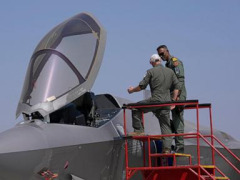BERLIN — Questions are mounting in Canada and in Europe over whether big-ticket purchases of high-end U.S. weaponry, such as the F-35 Joint Strike Fighter, are still a wise strategic choice for Western countries worried about their investment in U.S. defense technology.
In less than two months, U.S. President Donald Trump has upended decades of U.S. foreign policy. He has left NATO members questioning whether the U.S. will honor the alliance’s commitment to defend each other if other European countries are attacked by Russia. He’s also made repeat overtures to Russia and suspended most U.S. foreign aid.
And Pete Hegseth, Trump’s defense secretary, last month told a gathering of European defense ministers “that stark strategic realities” prevent the U.S. from being primarily focused on the security of Europe.
That could impact foreign sales of the Lockheed Martin-produced F-35 and other advanced U.S. jets like the F-16. As the war in Ukraine continues into its fourth year, it’s become clear that Eastern European NATO members still have vast stores of Soviet-era weapons in their stockpiles that were not interoperable with Western weaponry. A long-term plan to get all of NATO on similar platforms — by replacing old Soviet-era jets with Western ones, particularly the F-16 and in some cases, the F-35 — has gained momentum.
Some of the NATO countries are now re-thinking tying their defense to U.S.-made systems and potentially considering European jets like the Saab Gripen, Eurofighter Typhoon and Dassault Rafale instead.
In Canada, where Trump has launched a trade war and has threatened economic coercion to make it the 51st American state, new Prime Minister Mark Carney has asked Defense Minister Bill Blair to review its purchase of F-35s. Canada has been a partner with the U.S. in developing the F-35.
Blair will see if there are other options “given the changing environment,” a defense spokesman said.
And in Portugal, the outgoing defense minister said in an interview with a Portuguese newspaper published last week that “recent positions” taken by the U.S. compelled a rethink about the purchase of F-35s because the U.S. has become unpredictable. Portugal is considering various options to replace its F-16s.
“You’re not just buying an airplane, you’re buying a relationship with the United States,” said Winslow T. Wheeler, a longtime government watchdog who spent 30 years in the U.S. Congress working for Democrats and Republicans on national security and defense issues. “People in the past have not just welcomed but craved that kind of relationship.”
The Netherlands and Norway have voiced recent support for the F-35 program in comments to the media.
“The F-35 is a vital component of our national defense capability, and the cooperation and dialogue with the United States continues to support the development and use of this high-end platform,” Norwegian State Secretary Andreas Flåm said in a statement. ”We expect this constructive cooperation to continue into the future.”
The F-35 Joint Strike Fighter was designed to combine stealth, maneuverability and attack capabilities in a single aircraft. Each jet costs about $85 million (78 million euros), and the price jumps to $100 million (91 million euros) to $150 million (137 million euros) when supporting infrastructure and spare parts are included. About 1,100 have been produced to date for 16 military services across the globe.
The F-35B, a variant that can take off from ship decks verticall





